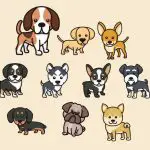Cavalier Spaniel
Description:
The Cavalier King Charles Spaniel is a graceful and happy toy spaniel that is larger than its close relative, the King Charles Spaniel. The Cavalier Spaniel has long ears which frame a domed head with a gentle expression and soft round eves. The Cavalier Spaniel retains some of the sporting dog breed characteristics and has a good nose and loves to go on walks. The well-feathered tail, which may or may not be docked, is constantly wagging. Cavalier Spaniels have a long silky and glossy coat with lots of feathering on the neck and chest. Colours seem to differentiate between four varieties of Cavaliers: Prince Charles is a tricolour dog with a white coat and black and tan markings; the Bleinham King Charles has the same white coat with chestnut-red markings; the third variety is the original Black and Tan; and the fourth variety is Ruby which is a solid red colour. Cavaliers are about 11 to 14 inches tall at shoulder height and weigh from 11 to
18 pounds. Cavaliers are members of the AKC Toy Dog Group.
History:
The Cavalier Spaniel was developed in 16th century England and became a favorite of European high society when King Charles II kept a large pack of these animals. Cavaliers frequently appeared in portraits of European aristocracy by Gainsborough, Rembrandt and Rubens. During this time, the Cavaliers role was to warm laps in chilly castles and on carriage rides. The Cavalier Spaniel was ranked 32nd out of 154 dog breeds in 2004 AKC registrations.
Temperament:
The Cavalier is a gentle, even-tempered, happy and playful small dog. Cavaliers make excellent family dogs who even like to play with small children (always under supervision of course). The Cavalier finds all humans delightful and loves to cuddle in their laps and snuggle in their beds. However, these comfort-loving Spaniels retain some of the characteristics of the sporting dog breeds. They love to run in the yard and chase chipmunks, squirrels, and birds. Cavaliers are easy to train but require early socialization as a puppy to overcome its natural timidity. Cavaliers make great family dogs. This breed also seems to do fine with first-time or novice dog owners.
Exercise:
Cavaliers don’t need a lot of exercise but they love to go on walks. Cavalier Spaniels can adapt to apartment living and can even adapt to being left alone during the day if they get walked regularly and get lots of attention in the morning and evening.
Grooming:
Cavalier Spaniels require brushing and combing twice per week and more often when shedding. The Cavaliers’ bottom should be kept trimmed for cleanliness.
Health Considerations:
Cavaliers generally live from 8 to 12 years and common health issues include: hip dysplasia, heart disease and eye problems.
Article type: xdogbreed

